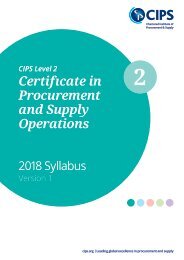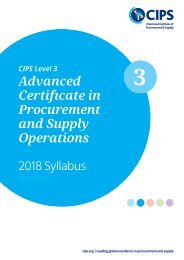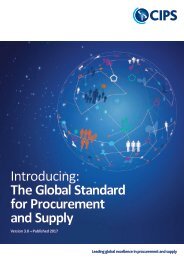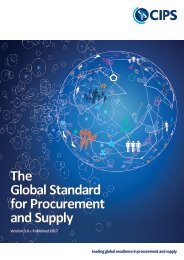CIPS_ProfDipProcSupp_L6_UCG_32pp_210sq_0517_WEB
Create successful ePaper yourself
Turn your PDF publications into a flip-book with our unique Google optimized e-Paper software.
Professional diploma in procurement and supply<br />
CREDIT VALUE 12<br />
UNIT PURPOSE<br />
AND AIM(S)<br />
On completion of this<br />
unit, candidates will be<br />
able to critically appraise<br />
strategies that can be<br />
adopted in the supply<br />
chain.<br />
This unit focuses on the<br />
development,<br />
configuration and roll out<br />
of strategy to help<br />
personnel appraise how<br />
strategy can be used to<br />
help achieve competitive<br />
advantage through<br />
improved supply chain<br />
management.<br />
Strategic supply chain<br />
management<br />
LEARNINg OUTCOMES<br />
1.0 Understand how strategic supply chain management can support and influence corporate<br />
and business levels of strategy<br />
1.1 Critically assess the relationship between functional, business and corporate levels of<br />
strategy<br />
• The relationship between the supply chain, business and corporate levels of strategy<br />
• The impact of supply chain management on business and corporate performance<br />
• The impact on profitability of the supply chain<br />
• Supply chain risks and their impact on business and corporate performance<br />
1.2 Evaluate the contribution of strategic supply chain management to corporate and business<br />
strategy<br />
• Creating sources of competitive advantage such as cost, improved quality, time to market,<br />
product and service differentiation<br />
• Enterprise profit optimisation<br />
• The use of outsourcing to achieve competitive advantage<br />
• Offshoring and sourcing from low cost countries<br />
• Quality improvement methodologies in the supply chain<br />
1.3 Evaluate the impact of market change on strategic supply chain management to support<br />
and influence corporate and business levels of strategy<br />
• STEEPLE (social, technical, economic, environmental, legislative and ethical) factors and<br />
their impact and risks on supply chains<br />
• Distinguishing between disruptive and incremental change<br />
• Changing markets and market volatility<br />
• The impact of globalisation on supply chains<br />
• Assess the supply chain risks of achieving expected international minimum standards.<br />
www.cips.org 13
















